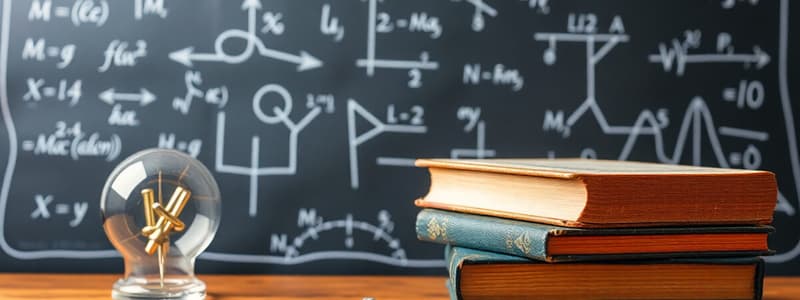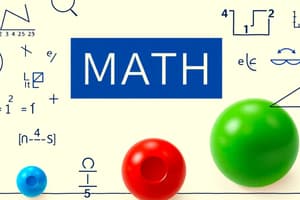Podcast
Questions and Answers
Koja od navedenih oblasti se bavi osnovnim operacijama na brojevima?
Koja od navedenih oblasti se bavi osnovnim operacijama na brojevima?
- Arhitektura
- Algebra
- Statistika
- Aritmetika (correct)
Šta se proučava u geometriji?
Šta se proučava u geometriji?
- Teoretička logika
- Svojstva brojeva
- Oblici, veličine i prostorni odnosi objekata (correct)
- Upravne metode
Koja oblast ispitije verovatnoću događaja?
Koja oblast ispitije verovatnoću događaja?
- Račun bez integrala
- Verovatnoća (correct)
- Algebra
- Statistika
Šta uključuje kalkulus?
Šta uključuje kalkulus?
Kakav je koncept funkcije u matematici?
Kakav je koncept funkcije u matematici?
Koja oblast matematike bavi se analizom i interpretacijom podataka?
Koja oblast matematike bavi se analizom i interpretacijom podataka?
Koji je cilj studije nizova i obrazaca?
Koji je cilj studije nizova i obrazaca?
Kako se matematička logika može najbolje opisati?
Kako se matematička logika može najbolje opisati?
Šta proučava geometrija?
Šta proučava geometrija?
Koja od sledećih oblasti matematike se bavi kontinuiranim promenama?
Koja od sledećih oblasti matematike se bavi kontinuiranim promenama?
Koji pojam se koristi za merenje centralne tendencije u statistici?
Koji pojam se koristi za merenje centralne tendencije u statistici?
Koji od sledećih alata nije matematički alat za prikazivanje podataka?
Koji od sledećih alata nije matematički alat za prikazivanje podataka?
Šta predstavlja teorem u matematici?
Šta predstavlja teorem u matematici?
Flashcards
Geometrija
Geometrija
Izučava oblike, veličine i osobine figura u prostoru, uz uspostavljanje veza između oblika, uglova i prostornog pozicioniranja.
Kalkulus
Kalkulus
Bavi se neprekidnim promenama i brzinama promena. Osnovno za probleme u fizici i inženjerstvu. Integralni kalkulus izračunava površine ispod krivih, a diferencijalni kalkulus ispituje trenutne brzine promena.
Statistika
Statistika
Alat za razumevanje podataka, obrazaca i trendova. Uključuje mere centralne tendencije (srednja vrednost, medijana, moda) i disperzije (varijansa, standardna devijacija).
Jednačina
Jednačina
Signup and view all the flashcards
Teorema
Teorema
Signup and view all the flashcards
Grana matematike
Grana matematike
Signup and view all the flashcards
Aritmetika
Aritmetika
Signup and view all the flashcards
Algebra
Algebra
Signup and view all the flashcards
Skup
Skup
Signup and view all the flashcards
Funkcija
Funkcija
Signup and view all the flashcards
Promenljiva
Promenljiva
Signup and view all the flashcards
Study Notes
Introduction to Mathematics
- Mathematics is a broad field that encompasses various branches, each with its own set of concepts, principles, and applications.
- It is a fundamental tool for understanding and modeling the world around us.
- Mathematics involves the study of quantities, structures, space, and change through logical reasoning and abstraction.
Branches of Mathematics
- Arithmetic: Deals with basic operations on numbers, including addition, subtraction, multiplication, and division.
- Algebra: Introduces the use of variables and symbols to represent unknown quantities and develop formulas and equations.
- Geometry: Explores shapes, sizes, and spatial relationships of objects.
- Calculus: Focuses on change, rates, and accumulation. Includes differential and integral calculus.
- Statistics: Involves collecting, organizing, analyzing, and interpreting data.
- Probability: Deals with the likelihood of events occurring.
- Number Theory: Concerns itself with the properties of numbers, integers, and their relationships.
- Linear Algebra: Involves vectors, matrices, and their applications.
- Discrete Mathematics: Studies mathematical structures that are discrete rather than continuous. Example: graphs.
Fundamental Concepts
- Sets: Collections of objects.
- Logic: The study of valid reasoning and argumentation.
- Proofs: Demonstrations of mathematical statements using logical deduction.
- Functions: Relationships between sets of inputs and outputs.
- Equations: Statements of equality between expressions.
- Inequalities: Statements showing relationships of greater than or less than.
- Patterns and Sequences: Ordered arrangements of numbers or objects.
Applications of Mathematics
- Science and Engineering: Used for modeling natural phenomena and designing technological systems.
- Computer Science: Essential for algorithms, data structures, and computer graphics.
- Business and Finance: Used for analysis, forecasting, and optimization.
- Social Sciences: Used for surveys, statistical analysis, and modeling social phenomena.
- Everyday Life: Used for budgeting, measuring, and problem solving.
Major Branches Explanations in Depth
- Algebra: Provides tools to solve equations and understand relationships between quantities. Variables allow representation of unknown values, leading to formulas and generalizations.
- Geometry: Studies shapes, sizes, and properties of figures in space. Demonstrates relationships between shapes, angles, and spatial positioning.
- Calculus: Deals with continuous change and rates of change. Fundamental for physics and engineering problems. Integral calculus calculates area under curves, differential calculus examines instantaneous rates of change.
- Statistics: A tool for understanding data, patterns, and trends. Incorporates measures of central tendency (mean, median, mode) and dispersion (variance, standard deviation).
Key Mathematical Tools and Techniques
- Equations: Tools to represent relationships and solve for unknown values.
- Graphs: Visual representations of data and relationships.
- Formulas: Representations of mathematical relationships using symbols and variables.
- Theorems: Proven statements; basis for further mathematical deductions.
- Proofs: Logical arguments to demonstrate the truth of mathematical statements.
Studying That Suits You
Use AI to generate personalized quizzes and flashcards to suit your learning preferences.




